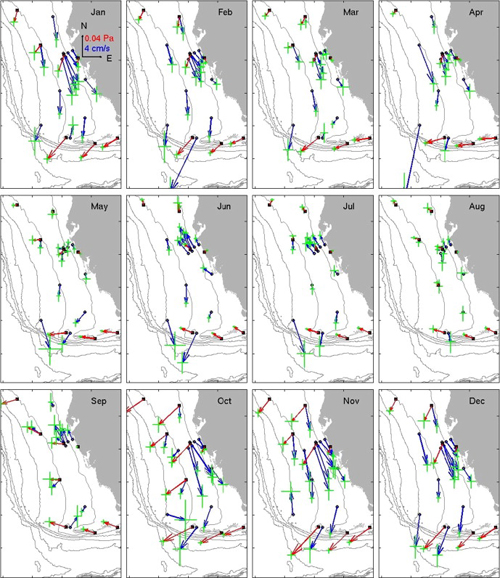|
The seasonal variations of the West Florida Continental Shelf (WFS) circulation and sea level are described using observations of velocity from an array of moored acoustic Doppler current profilers and various ancillary data. With record lengths ranging from 3 years to over a decade, a robust seasonal cycle in velocity is found, which varies across the shelf in a dynamically sensible way. Over most of the inner shelf these seasonal variations are primarily in response to local forcing, through Ekman-geostrophic spin-up, as previously found for the synoptic scale variability. Thus the inner shelf circulation is predominantly upwelling favorable from fall to spring months (October–April) and downwelling favorable during summer months (June–September). Seaward from about the 50 m isobath, where baroclinicity becomes of increasing importance, the seasonal variations are less pronounced. Over the outer shelf and near the southwestern end of the WFS, the seasonal variations are obscured by the deep ocean influences of the Gulf of Mexico Loop Current and its eddies. The seasonal variations in sea level are also robust. But unlike the velocity, these extend across the entire WFS and into the deep Gulf of Mexico. These seasonal sea level variations arise from two influences, one static, the other dynamic. The static influence projects onto the WFS by the static seasonal rise and fall of the Gulf of Mexico sea level due to heating and cooling (also occurring on the shelf). On climatological average, this ranges by about 0.12 m, with a minimum in February and a maximum in August and deriving primarily from the density variations over the upper 100 m of the water column. Such climatologically averaged variation due to temperature and salinity is also seen in satellite altimetry. An additional dynamic influence of about 0.06 m occurs over the inner shelf by the Ekman-geostrophic spin up to the seasonally varying winds. Together, the static and dynamic ocean responses result in a climatologically averaged coastal sea level variation at the central (vicinity of Tampa Bay to Charlotte Harbor) region of the WFS of about 0.18 m after adjustment for the inverted barometer effect, which adds about another 0.06 m for a total climatologically averaged annual sea level range of about 0.24 m. More details on seasonal variability can be seen in Liu and Weisberg [2012]. See Long-term mean current patterns on the WFS. References: Liu, Y., and R.H. Weisberg, 2012: Seasonal variability on the West Florida Shelf, Progress in Oceanography, 104, 80-98, doi:10.1016/j.pocean.2012.06.001. Weisberg, R.H., Y. Liu, and D.A. Mayer, 2009: Mean circulation on the west Florida continental shelf observed with long-term moorings. Geophysical Research Letters, 36, L19610, doi:10.1029/2009GL040028. |
Monthly mean climatology of wind stress (red) and depth-averaged velocity vectors (blue). The standard errors ε (green) of the mean values μ are shown as crosses (μ ± ε) at the arrow heads. Only the mean values estimated from records longer than 3 years are shown. (This is Figure 5 of Liu and Weiberg [2012]). |
See the citations of this paper [Liu and Weisberg, 2012] in Google Scholar.
